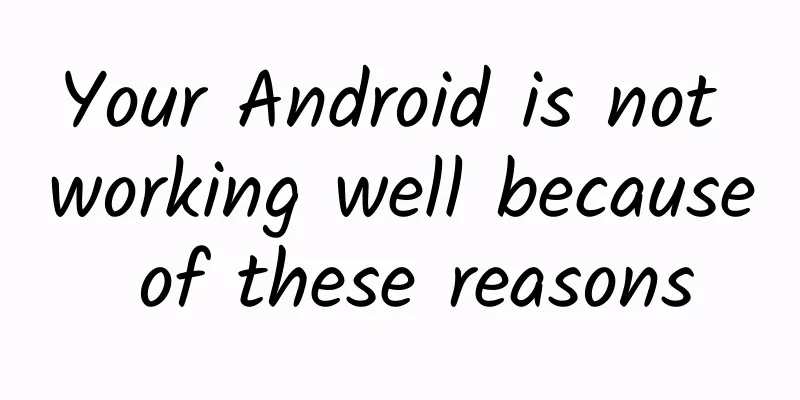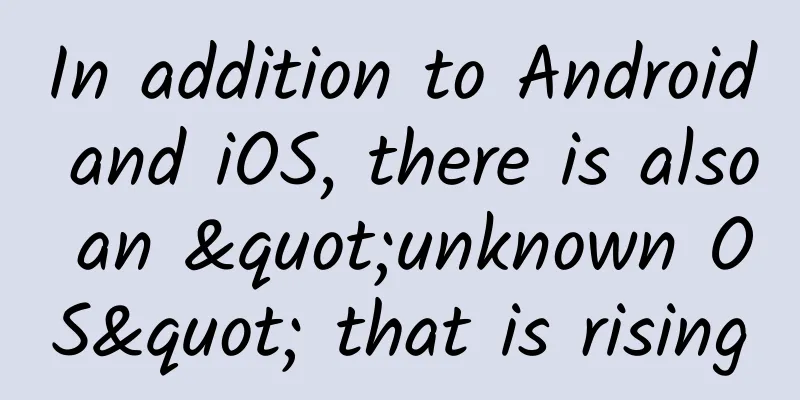Your Android is not working well because of these reasons

|
Android has long been the world's largest mobile operating system with the most users, but it is still far from being the world's most widely used. Everyone can easily name some bad experiences they have had, such as the phone freezing! The battery cannot be disabled! Ad pop-ups keep appearing! However, few people would ask why this is the case. What is the original design of Android? Is there any official fix? Is there any folk god who can make a patch solution? Few people may know that your impression of Android is far outdated, and many of its problems have been solved accordingly. Below, Zhaike will tell you why Android is not easy to use and what is Android like now? Phone freezesFrom a technical perspective, there are three main reasons for lag: Android applications use the Java language, which consumes more hardware resources than iOS's Object C; Android devices are too scattered, with at least half of them being mid- to low-end models; Android does not increase the priority of foreground processes, and too many background processes can easily occupy more resources. Although it is "naturally laggy", after several years of hard work, most Android devices now rarely experience lagging problems. Let's see how this problem has been improved. Early Android versions (v1.5+) did not have process management. Every time you opened a few apps, everyone would use third-party tools such as atk to kill background apps. Android 2.3 added process management, and finally you can use system settings to close apps, but you can only close them one by one. At this time, many tool apps already support one-click memory clearing. Android 4.1-4.4's "Grease Project" and subsequent improvements have greatly optimized small memory devices, making desktop switching more vivid and smooth. This is also due to the accelerated hardware upgrade, and the upgrade from single-core to dual-core and quad-core was completed in just over a year in 2013. Android 4.4 developed a new application runtime environment, ART. After switching to ART, opening and switching applications become very smooth, comparable to the desktop switching effect after the "Butter Project". However, ART requires developers to make applications compatible. Currently, most mainstream applications have made compatibility updates. In fact, in 2013-14, the performance of hardware has made Android smooth enough, but we still hear some complaints about lag. The reason is WeChat (people have expectations for games, so they don’t complain so much). If you have a little more WeChat friends and groups, it will gradually devour the memory of the device, and the cleaning tool can only slightly alleviate the situation. WeChat has become the reason for many people to upgrade their devices. Power is not disabledThe power consumption of mobile devices is not limited, but this is particularly obvious in Android. It is easy to compare that the usage time of an Android phone with a 3000mAh battery is similar to that of an iPhone with a 1500mAh battery, and sometimes even worse. However, this is already a big improvement, because the current Android system has much richer functions than before, and Wi-Fi, Bluetooth and GPS can be turned on all the time. Android's power consumption optimization is divided into two aspects: hardware and software. The hardware side was optimized around 2013. Previously, the power difference between "turning on Wi-Fi" and "not turning on Wi-Fi" was more than 10%, but now it doesn't make much difference. On the software side, the background applications are still working after standby, such as checking for new messages online. All message pushes on iOS use Apple's official push service. On Android, since Google's GCM is not mandatory and is not available in China, everyone uses their own or partners' push services. For example, if the same three applications receive messages, Apple completes the push once, while Android requires three pushes. Some manufacturers have added "aligned wakeup" to the ROM to allow Android to complete the push in one go, but it is believed that it can be bypassed. The proliferation of push services has become the biggest reason for Android's power consumption. At this time, "one-click background clearing" has a new meaning, from the initial relief of lag to the current power saving. Once the background is cleared, all problems will be solved. otherGoogle has been working hard to improve the Android experience, but it focuses more on the basic experience, such as lag and battery life. It lacks strength in other aspects, such as pop-up ads, abuse of permissions, and application cache files. These allow third-party security applications to play a role. LBE Security Master, 360 Mobile Guard, and Tencent Mobile Manager are based on this. This is no longer about Android conquering hardware, but a battle between mobile security companies and advertising companies. Pop-up ads were even more rampant a few years ago, and the notification bar of mobile phones was almost full of these ads. There were also some strange things that happened. The ad plug-in in a certain application was not activated at ordinary times, but it popped up ads when WeChat was started, making users think that WeChat was popping up. Later, almost all large-scale ad plug-ins were identified. Due to poor results, the current ad plug-ins have been much more restrained and only collect user information and display it in a fixed manner. Abuse of permissions is also terrible. The earliest version of WeChat automatically uploaded the user's address book, which is a typical example. The current way to deal with it is to use permission management software, which is integrated into most security applications. App cache cleaning may seem small, but if you think about Cheetah Cleanup Assistant and Cheetah Mobile, which is listed in the United States, you will know that this is definitely a pain point. From now on, the main reason why Android is not easy to use is the software experience, while the hardware experience is sufficient. The over-openness of the Android system has given it the most users, but it has also magnified the weakest end of the system. There were also pop-up ads and abuse of permissions in the Symbian era, but they were not a problem at that time, as most Symbian users could handle it themselves. Next time, if you are in a place with Apple fans, you can explain to them that Android is no longer what it used to be. |
<<: 12 classic keyboards in history
>>: Summary of iOS Graphics Programming
Recommend
Even the iPhone is no exception! Here are the 12 tech products that disappeared in 2015
According to PCWorld, tech products are like peopl...
Do we have to be better ourselves? Perfectionism is not "perfect"...
In daily life, perfectionism is often seen as a p...
How to seize the traffic of Xiaohongshu platform?
In today's world where consumer groups and co...
The tricks behind flooding your Moments with national flags!
The national flag was all over the WeChat Moments...
How much does Baidu paid ranking cost per month?
It depends on where you open Baidu, such as paid ...
How to come up with a good title, here are 5 key points to refer to
The first set of data : As of April 2017, the num...
When hot water and cold water are put into the refrigerator together, why does the hot water freeze first?
Image source: Pixabay In the hot summer, if you a...
2.4 million followers in one week, revealing the survival rules of Douyin vlog
Although the scale of Douyin 's vlogs is grad...
The suffering of Internet TV companies has just begun
In the past few years, those Internet TV brands t...
Langfang 4.2 magnitude earthquake, why others were woken up by the shaking, but I was sleeping soundly? !
According to the China Earthquake Networks Center...
Do you feel sleepy when it rains? Huaxi doctors say it may be because your brain is "hypnotized" by you
The rain in Chengdu is really capricious It's...
Two deaths in one month, NIO's head of autonomous driving: NOP is not autonomous driving and may exit at any time during operation
An obituary has once again put NIO at the center ...
A low-cost guide to marketing on Xiaohongshu!
A friend who is in the branding business asked: H...
Who says cats have no expressions? Humans have even designed a "Cat Expression Scale" specifically for them!
Leviathan Press: The reason why recognizing cat&#...
When Gree and Midea become the Apple of the air-conditioning industry, what is the purpose of the nine-year patent dispute between Samsung and others?
The domestic air-conditioning market has now ente...




![[Creative Cultivation Program] Did I invent the air conditioner to save you? Wrong, I invented it to save paper!](/upload/images/67f261e214851.webp)




